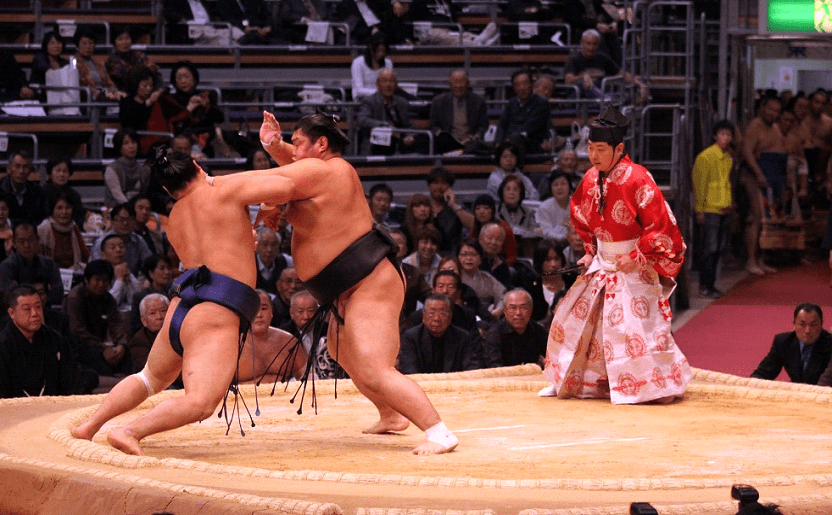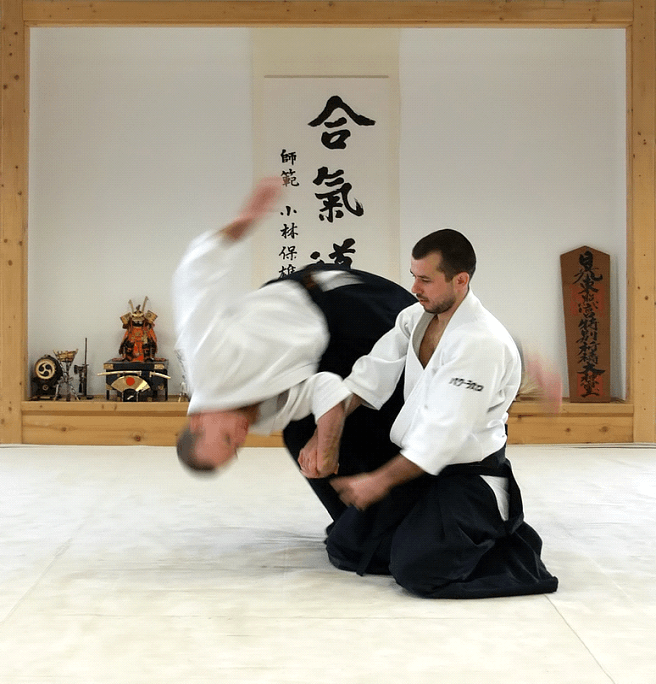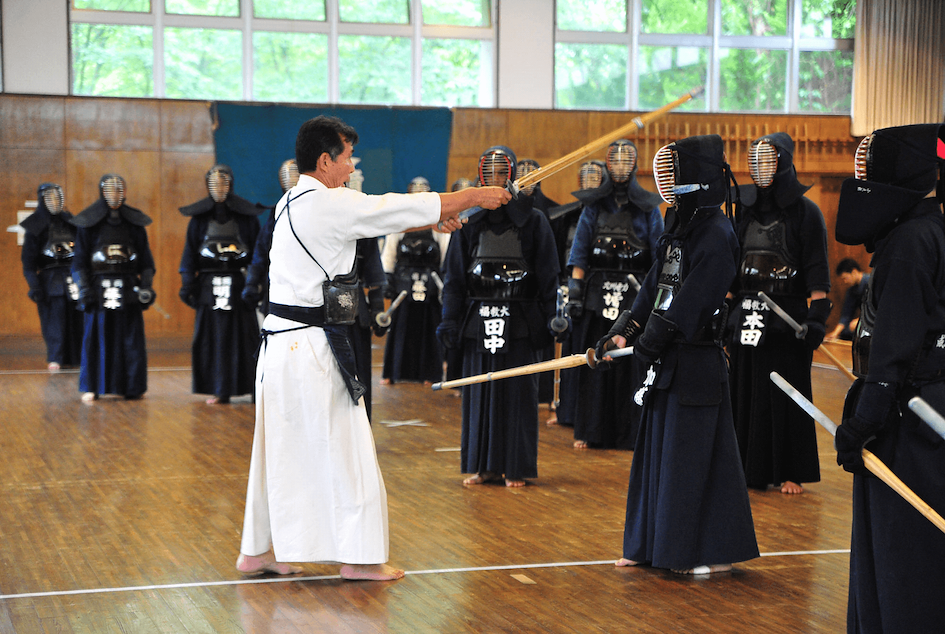[ad_1]
Traditional sports in Japan are culturally distinct and relevant. Despite Western-influenced sports’ popularity in Japan such as seen in baseball and soccer, traditional Japanese sports continue to captivate the locals and even the international community.
It’s no question why Japan continues to preserve these well-loved traditions. Wherever you go in Japan, these traditional sports have a strong presence in the form of gymnasiums, costumes, and souvenirs.
If you’re curious about these sports, you’ve come to the right place to learn more about these unique sporting traditions. In this guide, we’ll take you through the most important facts you should know about the five most well-known traditional sports in Japan.
Sumo: A Way of Life
Sumo wrestlers inside the ring. Photo courtesy of Brittanica.
What is Sumo?
Of all the traditional Japanese sports, Sumo wrestling is easily the most recognized sport. For one, it’s the national sport of Japan. Moreover, the sumo wrestlers are icons of a highly regimented life dedicated to this ancient sport and in honor of Shinto deities.
The goal of the sport is simple. The sumo wrestler (rikishi) must force his opponent outside the drawn ring (Dohyō) or make any part of their opponent’s body, other than the soles of their feet, hit the ground.
The Rikishi who does any of this against their opponent is immediately declared the winner.
A sumo match typically lasts a few seconds. However, there are also rare instances when a match may be longer than a minute or more.
How to Witness a Sumo Match
A sumo wrestler performs a ceremony at a grand sumo tournament in Ryogoku Kokugikan. Photo courtesy of The Japan Times
There’s no better way to experience the sumo wrestling tradition than to attend a sumo wrestling tournament.
To date, Japan is the only country to professionalize sumo wrestling. Japan Sumo Association governs professional sumo wrestling and holds tournaments throughout the country.
Should you be visiting Japan, it’s best to schedule your visit around the time when these tournaments are held every year:
⦁ Three (3) tournaments in Tokyo (January, May, and September)
⦁ One (1) tournament in Osaka (March)
⦁ One (1) tournament in Nagoya (July)
⦁ One (1) tournament in Fukuoka (November)
The tournament lasts 15 days. A tournament day typically starts as early as 8:00AM; the last match is usually scheduled at 18:00PM.
The sumo wrestling tournaments draw large crowds! The tickets sell out really fast. So, it’s best to plan ahead by checking the official schedule of these tournaments.
Sumo Attractions
A virtual tour of Ryogoku District, Tokyo, considered the home of sumo wrestling. Video courtesy of BURA BURA TV on YouTube.
If your visit to Japan happens to be scheduled in between the official sumo tournaments, you still have several options to experience sumo wrestling.
⦁ Minor Sumo Events
In between the official tournaments, there are several exhibition sumo wrestling tournaments held across the country. Most of these events feature exhibition matches, light rituals, and even retirement ceremonies of a rikishi.
⦁ Sumo Stable
Visiting a sumo stable is another cool way to appreciate sumo. A sumo stable is where almost all aspects of a wrestler’s life—from eating to training to sleeping—are managed by a stable master.
Unfortunately, very few sumo stables accept visitors. Your best option to visit a stable is to book the services of organizations that offer planned and exclusive tours.
⦁ Ryogoku District
Located in Tokyo, Ryogoku District has served as the sumo world’s center for over two centuries. Here you’ll find many sumo stables, the Sumo Museum, and even restaurants managed by retired wrestlers.
Sumo Terms You Should Know
⦁ Rikishi: professional sumo wrestler
⦁ Dohyō: usually an elevated ring for a sumo match
⦁ Mawashi: loincloth worn by wrestlers
To know more about Sumo wrestling, you can check out “Sumo Encyclopedia” by Naruo Morita. Aside from the technical terms, the book comes in handy with special stories from sumo wrestlers.
Judo: The Defensive Way
A judoka attempts to slam his opponent to the ground in a competitive judo match. Photo Courtesy of IJF.org
What is Judo?
Judo is another popular traditional Japanese martial art that emphasizes self-defense. Judo’s literal translation is “the gentle way” and it speaks of the art’s priority: self-defense strategy over pure strength.
As a sport, Judo has complex rules. Simply put, however, Judo’s main objective is to make the opponent yield.
A judo practitioner can use techniques like throwing the opponent and grappling or striking the opponent’s body parts like the arm or neck.
Founded by Jigoro Kano who extensively laid the principles in this book, Judo continues to be a staple sport across the country. Its popularity even soared further because it is an official Olympic sport, too!
How to Witness Judo
Front view of the Kodokan Judo Institutes’ main building in Bunkyo, Tokyo. Photo Courtesy of Kodokan Judo Institute
The quickest way to experience Judo firsthand is to visit Kodokan Dojo in Bunkyo Ward, Tokyo.
Jigoro Kano founded this school in a small temple in Tokyo. Presently, the Kodokan is highly regarded as the best institution to learn Judo.
Visitors can watch Judo training sessions from the spectator’s area on weekdays and Saturdays at designated times inside the Kodokan.
Because of Judo’s sporting fame in recent years, several competitive Judo tournaments have popped up all over the world.
You may also check out live tournaments in key cities where the sport has gained significant attention. All these details are found in the World Tour section of the International Judo Federation’s website.
Judo Terms You Should Know
⦁ Judoka: a person practicing judo
⦁ Judogi: the traditional clothing used to practice judo
⦁ Waza : techniques in judo
A great way to experience Judo whether as a practitioner or spectator is to put on the judogi. Here’s a judogi uniform set that’ll make you feel the spirit of Judo.
Aikido: The Way of Unifying
An Aikido practitioner subdues his opponent to the ground. Photo Courtesy of Wikipedia.
What is Aikido?
Unlike the other mentioned sports in this beginner’s guide, Aikido is a relatively more modern form of martial arts and self-defense. Aikido resembles some jujitsu, karate, and judo techniques.
Morihei Ueshiba, who developed Aikido, sought to create this martial art as a form of a practitioner’s self-defense while protecting their opponents from further injuries.
Aikido’s techniques involve circular movements and fluid motions that allow practitioners to redirect the force of an attack.
Ultimately, it’s this concept in Aikido that unifies life’s energy to overcome personal aggression.
How to Witness Aikido
While Aikido functions more like a self-defense system and is not regarded as a competition, that doesn’t mean that nobody can watch Aikido in action.
A group of students are having their Aikido training inside the Hombu Dojo. Photo courtesy of International Aikido Federation.
The best way to witness Aikido is to visit an Aikido dojo such as the Hombu Dojo in Shinjuku City, Tokyo.
The Aikikai Foundation manages the dojo and holds Aikido classes for interested people regardless of age or sex.
Aikido Terms You Should Know
⦁ Uke: the person who attacks but will receive the Aikido technique
⦁ Tori: the one that defends the attack by applying aikido
⦁ Hakama: traditional clothing in Aikido
To discover more about Aikido, another good resource would be “Aikido—The Way of Harmony” by John Stevens and Shirata Rinjiro.
Kendo: The Way of the Sword
Two competitors attempt to hit each other during the 67th All Japan Kendo Championships. Photo Courtesy of Kendo Jidai International
What is Kendo?
Literally translated to “the way of the sword,” Kendo is another traditional Japanese sport that traces its roots all the way to the samurai era.
At first glance, Kendo appears to be merely two competitors hitting each other with a wooden stick (shinai). But if there’s one aspect that Kendo highlights, then it would be living an upright and moral life.
As a competitive sport, a Kendo match is typically a three-point match. A competitor earns a point for delivering a blow to the scoring areas (e.g., left or right side of the head, left or right side of the trunk, or either wrist).
The competitor who scores two points first or has more points after match time wins the match.
How to Witness Kendo
Kendo has permeated different levels of Japanese life. The Japanese police force trains their people in Kendo; even schools have Kendo clubs. There’s a good chance that you may see public sparring sessions in these locations.
Sumi Masatake conducts a training session with judo practitioners in a dojo. Photo courtesy of Kendo Jidai International.
If you want to see competitive Kendo action, then the All Japan Kendo Championships is the place to be. It’s the most prestigious Kendo event for the Japanese kendoka.
Not to forget, there’s also the World Kendo Championship which only occurs every three years. This event isn’t necessarily held in Japan.
In fact, the next tournament is in 2024, and it will be held in Milan, Italy.
Kendo Terms You Should Know
⦁ Kendogu: protective helmet for kendo
⦁ Shinai: bamboo sword used to hit opponents in kendo
⦁ Kendoka: the kendo practitioners
Kendo requires that its practitioners have the right costumes and equipment.
You can start your kendo experience with this protective kendo set and wooden sword.
Kyūdō: The Way of the Bow
Several men are practicing their aim during a Kyūdō training session inside a dojo. Photo Courtesy of International Kyūdō Federation
What is Kyudo?
Kyūdō, the traditional Japanese art of archery, is a captivating sport that emphasizes the blend of grace, concentration, and precision.
Zen philosophy has heavily influenced this sport. Moreover, Kyūdō focuses not only on hitting specific targets. Through the way of the bow, one can achieve inner harmony and self-improvement
While Kyūdō is often seen as a creative form of self-improvement, several organizations hold competitive Kyūdō tournaments.
Typically, there are two types of competition—the close target (approximately 28 meters) and the far target (approximately 60 meters). Kyūdō practitioners either compete as individuals or as a team. The winner is decided by the number of successful hits.
How to Witness Kyudo
There are fewer Kyūdō tournaments compared to other traditional sports. Fortunately, some dojos also allow outsiders to watch practice sessions.
Highlights of the 2018 All Japan Invitational College Championship. Video courtesy of Kyudo on YouTube.
A good number of organizations, like the All Nippon Kyudo Federation, in Japan still continue to hold traditional Kyūdō competitions. These events are the best avenues to witness top-notch Kyūdō in action.
If your visit won’t coincide with the mentioned events, the Nippon Budokan near the Imperial Palace in Tokyo can be your next best chance to witness a Kyudo demonstration or exhibit.
Kyūdō Terms You Should Know
⦁ Yugake: an archer’s glove
⦁ Yumi: traditional Japanese asymmetric bow at over 2 meters tall
⦁ Ya: arrow used alongside the yumi in Kyūdō
Like many other traditional Japanese sports, Kyūdō also requires intricately prepared costumes and tools. To get a real feel of what it feels like to participate in Kyudo, be sure to check out this archery jacket and these special arrows.
Conclusion
Traditional Japanese sports reflect the values deeply embedded in Japanese society.
People across the world take so much interest in traditional Japanese sports because they are distinct and iconic. These traditional sports continue to thrive because they don’t just highlight athletic prowess.
Instead, these sporting traditions allow people to pursue personal excellence, cultivate a strong spirit, and preserve a rich cultural legacy.
This beginner’s guide to traditional Japanese sports has covered the more well-known sports. Know, however, that you’ll most likely encounter other traditional sports on your next visit to Japan.
To get your hands on all things related to traditional Japanese sports, be sure to sign up for a ZenMarket account for an easier and more efficient online shopping experience straight from Japan.
[ad_2]
Source link











